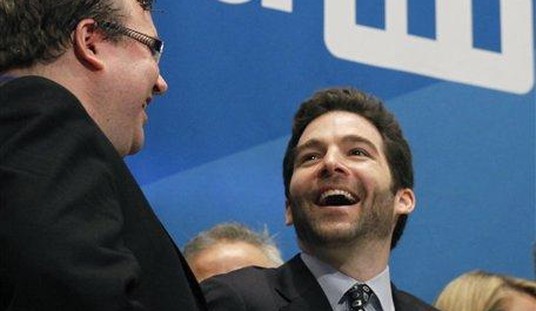I saw this data about five minutes after reading a story about Krispy Kreme’s new promotion, offering a free donut to everyone who’s been vaccinated every day for the rest of the year.
More than 250 free donuts, if you want ’em.
And if these numbers are accurate, a lot of us want ’em.
Holy cow: 42% of Americans report undesired weight gain during Covid 19. The average weight gain is 29 lbs. And 41 lbs for Millennials! This will ramify for years to come. https://t.co/iRnyMDxbmX pic.twitter.com/tR9tcnt4s7
— Jonathan Rauch (@jon_rauch) March 22, 2021
Are those numbers accurate, though? I can buy that 42 percent of Americans have gained weight during the pandemic. (I’ve lost 20, although only half of that was intentional.) But I can’t buy that the average gainer has packed on 29 lbs., with 10 percent claiming they’ve gained more than 50. There’s no way. The APA, which sponsored the survey, says that the *median* gain was a more plausible 15 lbs. so maybe there’s a smaller cohort that’s gained a ton that’s dragging the average up.
But still. Ten percent gained 50 lbs. or more? No way. “People are terrible at accurately self-reporting in surveys, especially things they need to quantify,” notes pollster Patrick Ruffini, which may explain this. But then we’re left to wonder why the 15-lbs. median seems more reasonable.
The newsy part of the survey is how much weight has (allegedly) been gained, not that weight gain is happening. Doctors have known that for months. The dynamics of the pandemic made it inevitable. There’s the stress of protracted isolation, the stress of having to get one’s kids educated without help from the state, and the stress of working from home (or, worse, unemployment). Alternately, there’s depression and boredom — lots of it, as social engagements dry up and local attractions shut down. There are fewer opportunities for exercise since gyms are a hot spot for COVID transmission and what exercise we do get tends to be lower intensity. And there’s sleep disruption, which can also disrupt eating habits. Combine all of that with the fact that Americans working from home are now within a few feet of their fridge at all hours and it was a fait accompli that people would pack on the pounds by finding solace in food and alcohol. Especially since the comfort foods they’re reaching for tend to be higher in calories and sugar.
But 29 lbs. on average among gainers? Nah. If that number’s anywhere near accurate, America’s health-care industry will have all sorts of knock-on health effects to cope with in the next few years as we move past managing the COVID epidemic and into managing the obesity epidemic.
As for the possibility that there are outliers dragging up the average, a study published a few months ago about weight gain during the pandemic suggests that it’s people who were overweight before it began who are suffering disproportionately:
“Individuals with obesity were impacted the most — and that’s what we were afraid of,” said Emily Flanagan, an author of the study and postdoctoral fellow at the Pennington Biomedical Research Center. “They not only started off with higher anxiety levels before the pandemic, but they also had the largest increase in anxiety levels throughout the pandemic.”…
It was unclear why exactly, but one reason may have been concerns about the virus. The survey took place at a time when studies were first beginning to show that excess weight puts people at a much higher risk of being hospitalized with Covid-19. “We don’t have data to back this up, but our hypothesis is there was a lot more anxiety about their own health,” Dr. Flanagan said. “A heightened fear of the virus would most certainly increase their anxiety levels.”
Discovering that COVID preys on those with comorbidities like obesity may have frightened people with poor eating habits into stress-eating more, further increasing their risk.
Anyway: What happens when the pandemic finally eases? Does America shed its COVID “19” or do we continue to pack it on? Some will want to hit the gym and get back into shape for dating and socializing ASAP but others will avail themselves of all the restaurants and bars they missed out on for the past year. And not just quality restaurants either: Surely there’s a cohort of risk-averse people who’ve been limiting their trips to fast-food places who’ll want to make up for lost time. The understandable consensus right now is that the country’s going to let loose this summer and probably into next year to have all the fun it was denied since last March, with the possibility of a new “Roaring 20s” for the rest of the decade to follow a la the decade after the 1918 flu pandemic. But indulgence rarely makes for good health. Waistlines could get bigger before they start to get smaller again — assuming they ever start to get smaller again. This country’s not known for tightening its belts.
For a possible glimpse of what post-COVID America’s going to look like, watch the mayor of Miami Beach discussing the 8 p.m. curfew he’s had to impose during spring break to try to manage the raucous crowds that have showed up. Such is the crush of people that even the SWAT team has been called in to help. They’re not college kids for the most part, local officials told the AP. These are adults, and they’re not coming to eat in restaurants and sit in bars. They’re having “impromptu street parties,” seemingly content to drink and just mill about in huge crowds like in the Before Times. When the cops moved on a crowd on Saturday night to enforce the curfew and make people disperse, some reportedly “responded by jumping on top of cars, twerking and throwing money into the air.” It might be Fat Tuesday in America all this summer and beyond. In more ways than one.








Join the conversation as a VIP Member